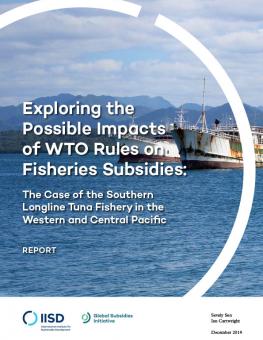
Exploring the Possible Impacts of WTO Rules on Fisheries Subsidies: The Case of the Southern Longline Tuna Fishery in the Western and Central Pacific
This case study explores the potential impact of new rules on fisheries subsidies on the southern longline tuna fishery in the Western and Central Pacific ocean.
-
The southern longline #tuna fishery in the Western and Central Pacific suffers from economic #overfishing: stocks are healthy, but the number of vessels operating means catch size (with the same amount of fishing effort) has been declining.
-
If enough fishing effort was removed, the overall economic situation of the fishery could improve, providing the Pacific Islands with opportunities to develop their domestic #tuna industry.
Key Messages
- The southern longline tuna fishery in the Western and Central Pacific suffers from economic overfishing. Stocks of tuna (albacore, yellowfin and bigeye) are healthy, but the number of vessels operating in the fishery means that the quantity of fish that vessels are able to catch with the same amount of fishing effort has been declining.
- Several fleets in the fishery appear to be subsidized, but to different effects. Catch revenues may not cover operating costs for vessels from some distant water fishing nations, which account for most of the total catch in the fishery. A subsidy prohibition could thus have an impact on some of these vessels’ ability to operate and the level of fishing effort in the fishery.
- The exit of vessels affected by new subsidy rules may have an impact on Pacific Island countries’ domestic processing in the short term. However, if sufficient fishing effort were removed from the fishery, it is possible that the overall economic situation of the fishery could improve, providing the Pacific Islands with opportunities to develop their domestic tuna industry.
The United Nations 2030 Agenda for Sustainable Development includes a specific target (Sustainable Development Goal 14.6) of completing, by 2020, negotiations at the World Trade Organization (WTO) to discipline fisheries subsidies. In the context of these negotiations, new rules are discussed in three specific areas: (1) subsidies that contribute to illegal, unreported and unregulated fishing, (2) subsidies to the fishing of stocks that are already overfished and (3) subsidies that contribute to overfishing and overcapacity more broadly. To help build an understanding of how possible subsidy rules might apply in practice, the International Institute for Sustainable Development has produced three case studies to explore the possible impact of such WTO subsidy disciplines in three fisheries in distinct geographical areas.
This case study looks at the southern longline tuna fishery in the Western and Central Pacific ocean. It provides an overview of the fishery and its governance, examines the subsidy patterns of fleets operating in the fishery and assesses qualitatively the impacts that different possible WTO rules on fisheries subsidies could have on different fleets. It also provides insights about potential pathways for the reform of harmful fisheries subsidies.
Additional downloads
You might also be interested in
Deep Dive Into Fisheries Subsidies, Part 1
Overfishing has reached alarming proportions in West Africa, affecting the local economy, culture and people's daily lives. How can a WTO agreement on fisheries subsidies help?
Fisheries Subsidies Video Series
As part of its work to support a meaningful WTO agreement to discipline harmful fisheries subsidies, the IISD has produced a series of six videos to summarize the key issues to be resolved across the WTO fisheries subsidies negotiations.
WTO Negotiations on Fisheries Subsidies: What's the state of play?
With only a few months to conclude WTO talks on fisheries subsidies, this update is an overview of the draft text circulated by the Chair of negotiations.
Potential Implementation Steps of a WTO Agreement on Fisheries Subsidies
As members of the WTO negotiate new rules to curb harmful fisheries subsidies, this policy brief examines the potential steps governments could take to implement successful subsidy reform that promotes more sustainable fisheries.